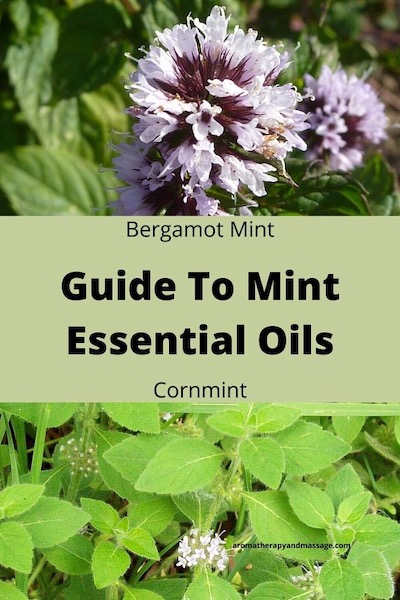- Home
- Essential Oil Profiles
- Mint Essential Oils
As an affiliate for Bookshop, Amazon, and other programs, I may earn a small commission for products purchased through links. This doesn't affect the price you pay. Privacy policy and disclosures.
Search this site:
Two Mint Essential Oils You Might Not Know
The most well-known and commonly used mint essential oils are peppermint (Mentha piperita) and spearmint (Mentha spicata). This article looks at the lesser known oils of bergamot mint (Mentha citrata) and cornmint (Mentha arvensis).
All mint essential oils are from the plant family Lamiaceae.

Bergamot Mint Essential Oil
Bergamot mint (Mentha citrata), also called orange mint or Eau de Cologne mint, is different from the more commonly used bergamot (Citrus bergamia).
Production: Steam distilled from the herb's flowers.
Aroma: Sweet, herbaceous, minty with subtle underlying citrus and floral.
Perfume/Aromatic note: Top to middle
Is bergamot mint safe to use during pregnancy? Yes, according to Plant Therapy. Consult a professional for specifics.
Is bergamot mint essential oil safe for children? Yes, according to Eden's Garden.
Main components:
- linalyl acetate 34.0–57.3%
- linalool 24.9–55.2%
Source: Essential Oil Safety, 2nd Edition
Bergamot Mint Essential Oil Benefits and Uses
The Heart of Aromatherapy: Use bergamot mint to support the respiratory system, clear mucous and congestion, soothe sore muscles, support digestion, ease nausea, and feel motivated and inspired. This oil's chemistry is similar to lavender and is very skin friendly. The book offers this relaxing diffuser blend:
- 5 drops bergamot mint
- 2 drops lime essential oil
- 2 drops yuzu essential oil
- 1 drop orange essential oil
The Aromatherapy Companion: Bergamot mint has an affinity for the muscular system. Use the oil to help relieve rheumatic pain and muscle tension, aches, pains, spasms, and cramps. Also use this essential oil for anxiety, insomnia, mental fatigue or strain, feelings of being overwhelmed, stress and stress-related conditions, excessive thinking or worry, and mental tension.
Plant Therapy: Use bergamot mint to help calm agitated emotions, in DIY body care, or diffuse the essential oil to help clear congestion and support the respiratory system.
Stress-Relief Inhaler: Place 8 drops bergamot mint and 8 drops orange essential oil on the wick of an aromatherapy inhaler. Source: Essential Living.
Breathing for Deep Sleep Oil
- 2 tablespoons (1 ounce) jojoba oil
- 10 drops bergamot mint essential oil
- 4 drops eucalyptus essential oil
- 4 drops cedarwood essential oil
Blend all oils in a 1-ounce (30 ml) glass jar. Massage some of the blend into your chest, shoulders, and upper arms when sniffles or a stuffy nose are keeping you awake.
You can use this blend throughout the evening as you wind down from your day, giving the oils time to take effect even before you go to bed.
If you want to make this blend for kids over age five, take out the eucalyptus and use this recipe:
- 2 tablespoons jojoba oil
- 4 drops bergamot mint
- 2 drops cedarwood essential oil
Diffuser Blend for Creative Inspiration
- 6 drops bergamot mint essential oil
- 1 drop peppermint essential oil
- 3 drops laurel leaf essential oil (Laurus nobilis)
Source: Aromahead Newsletter
Uplifting Blend
For a stock blend to use in a diffuser or personal aromatherapy inhaler, combine 50 drops bergamot mint, 25 drops rose geranium, and 25 drops yuzu in a dropper bottle. Source: Eden's Garden
Cornmint Essential Oil
Cornmint essential oil (Mentha arvensis) is also called Japanese or wild mint. Although this oil is not commonly used in holistic aromatherapy—peppermint is preferred—cornmint is a lower-cost substitute for peppermint for fragrancing and soapmaking.
Production: Steam distilled from the leaves. Because the distilled oil is about 85% menthol, most of the oil sold has been dementholized. (When buying the oil, know whether it's dementholized or not.) Much of the world's menthol comes from the cornmint plant.
Aroma: Minty, warm, and herbaceous.
Perfume/Aromatic note: Top
Is cornmint safe to use during pregnancy? Probably not. Consult a professional.
Is cornmint essential oil safe for children? Do not use on babies or young children.
Main components of dementholized cornmint:
- menthol 28.8–34.7%
- menthone 16.3–31.1%
- isomenthone 6.8–12.1%
- limonene 5.8–9.6%
Note: Cornmint that's not dementholized can have menthol content as high as 80%.
People with cardiac fibrillation or a G6PD deficiency should avoid cornmint.
Source: Essential Oil Safety, 2nd Edition
Cornmint Essential Oil Benefits and Uses
375 Essential Oils and Hydrosols: Cornmint is considered a tonic stimulant and may stupefy at high doses. The oil may help relieve migraines and headaches.
The Aromatherapy Encyclopedia: Cornmint improves digestion, relieves flatulence, opens the sinuses, uplifts the mood, lessens pain, and repels insects.
Aromatics:
Diffuse the refreshing scent of cornmint to help focus, wake up the senses, and promote optimism. The oil's cooling effect works well in massage oil blends for muscles and joints. To support digestion, use this essential oil in an inhaler.
Base Formula:
Cornmint can help soothe itching, rashes, and eczema and also assist in
the healing of wounds. This refreshing, stimulating oil promotes
alertness and concentration and is useful in alleviating fatigue and
shock. Cornmint essential oil may help relieve digestive upsets, respiratory problems, headaches, migraines, and muscle aches and pains.
Cooling Foot Spray
- 25 to 30 drops cornmint essential oil
- 5 to 8 drops rosemary essential oil
- 2 tablespoon aloe vera gel
- 2 tablespoon witch hazel extract
Mix all ingredients into a 4-ounce spray bottle. Shake well before use. Store in the refrigerator for an even cooler effect.
Note: You may want to add a solubilizer to blend the essential oils with the carriers.
Queasy Tummy Rub
In a 10-ml roller bottle combine:
- 2 tablespoons carrier oil
- 10 drops cornmint essential oil
- 4 drops ginger essential oil
- 4 drops orange essential oil
To use, apply to the abdomen and and massage in a clockwise direction.
Source: Rocky Mountain Oils
Reduce Hot Flashes
- 6 tablespoons aloe vera gel
- 1 teaspoon rosehip oil
- 3/4 teaspoon rose hydrosol
- 7 drops cornmint essential oil
- 7 drops peppermint essential oil
- 6 drops lavender essential oil
- 6 drops sandalwood essential oil
- Put the aloe vera gel into a 4-ounce glass jar and stir.
- Stir in the rosehip oil.
- Mix in the hydrosol.
- Drop in the essential oils. Stir well.
- Put on the lid, label, and store in a cool, dark place.
Use throughout the day as needed and before going to bed by applying to your chest and the back of the neck.
Adapted from Penny Price
Buy essential oils from Aromatics International (recommended).
Rocky Mountain Essential Oils.
Photo Credits: Bergamot mint by Magnus Manske, CC BY-SA 3.0, via Wikimedia Commons. Cornmint by AnemoneProjectors, CC BY-SA 2.0, via Wikimedia Commons.



